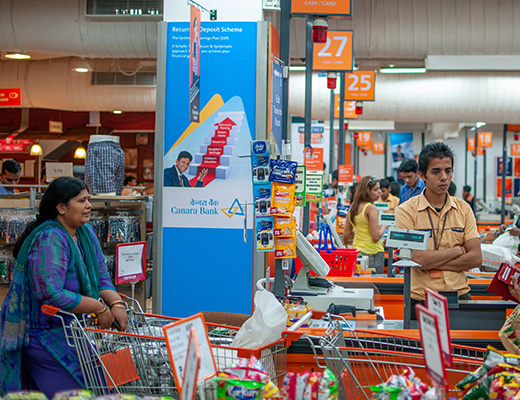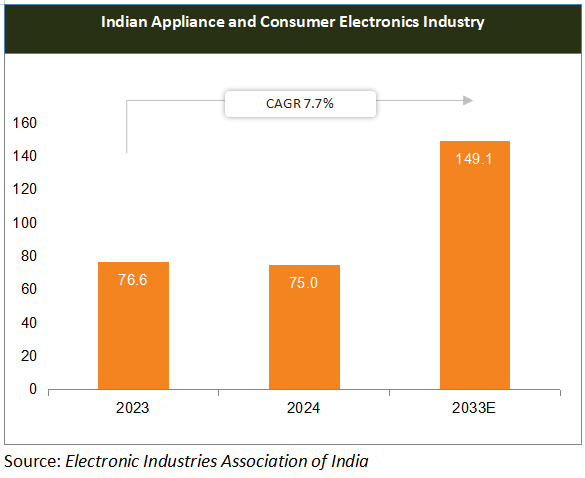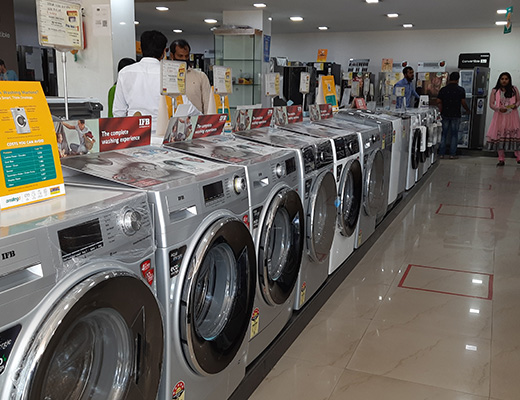Advantage India
Growing
Demand
* In 2025, the revenue of the headphones market in India is estimated at Rs. 22,433 crore (US$ 2.56 billion) and is expected to register an annual growth rate of 2.45% (CAGR 2025-2030).
* As of August 2025, India’s dishwasher market is valued between Rs. 596 crore (US$ 68 million) and Rs. 745 crore (US$ 85 million). The market is projected to expand at a CAGR of 3-12% over the next 10 years, with annual sales expected to surpass 1,85,000 units by 2030.
* Average monthly spending on consumer durables soared by 72% in FY25, fuelled by a growing wave of home ownership and the demand for furnishing new homes with appliances, according to the CMS Consumption Report 2025.
Opportunities
* Tech players such as Play (a tech brand) are focusing on tapping the Indian consumer electronics market, developing an electronic components manufacturing base in India, and encouraging export.
* In 2023-24, India’s workforce stood at 590 million, with 13.6% in formal and 86.4% in informal jobs. The formal temporary workforce reached 5.4 million in 2024, growing steadily from 2019-20 to 2023-24, as firms increasingly adopt flexible staffing for demand shifts and compliance needs.
* With robust growth, India aims to achieve electronics manufacturing worth US$ 300 billion in electronics and exports of US$ 120 billion by FY26.
Policy
Support
* 100% FDI allowed in the electronics hardware-manufacturing.
* As of January 20, 2025, under the PLI Scheme for White Goods (Air Conditioners and LED Lights) approved for 2021-22 to 2028-29 with an outlay of Rs. 6,238 crore (US$ 711.85 million), 84 companies have committed investments of Rs. 10,478 crore (US$ 1.20 billion), expected to generate production worth Rs. 1,72,663 crore (US$ 19.70 billion) during the scheme period.
Increasing
Investments
* Between April 2000-March 2025, electronic goods attracted FDI inflows of Rs. 49,715 crore (US$ 6.87 billion).
* The setting up of a Rs. 417 crore (US$ 47.6 million) Electronics Manufacturing Cluster (EMC 2.0) at Gautam Buddha Nagar, Uttar Pradesh. It aims to boost local manufacturing and innovation.
IBEF Campaigns
MORE
Aatmanirbhar Bharat Utsav 2024
Union Minister of External Affairs, Dr. S. Jaishankar and Union Commerce an...
Case Studies
MOREIBEF BLOG
MORERevival of India’s Forgotten Superfoods: Jackfruit, Amaranth and Moringa in Global Diets
For centuries, Indian kitchens have been home to an incredible diversity of...
Next-Gen GST: Powering India’s Investment and Demand Surge
India’s recent Goods and Services Tax (GST) overhaul is more than a s...
Transforming Spaces: The Growth and Opportunities in India’s Home Décor Industry
India’s home décor industry is evolving into one of the most d...















